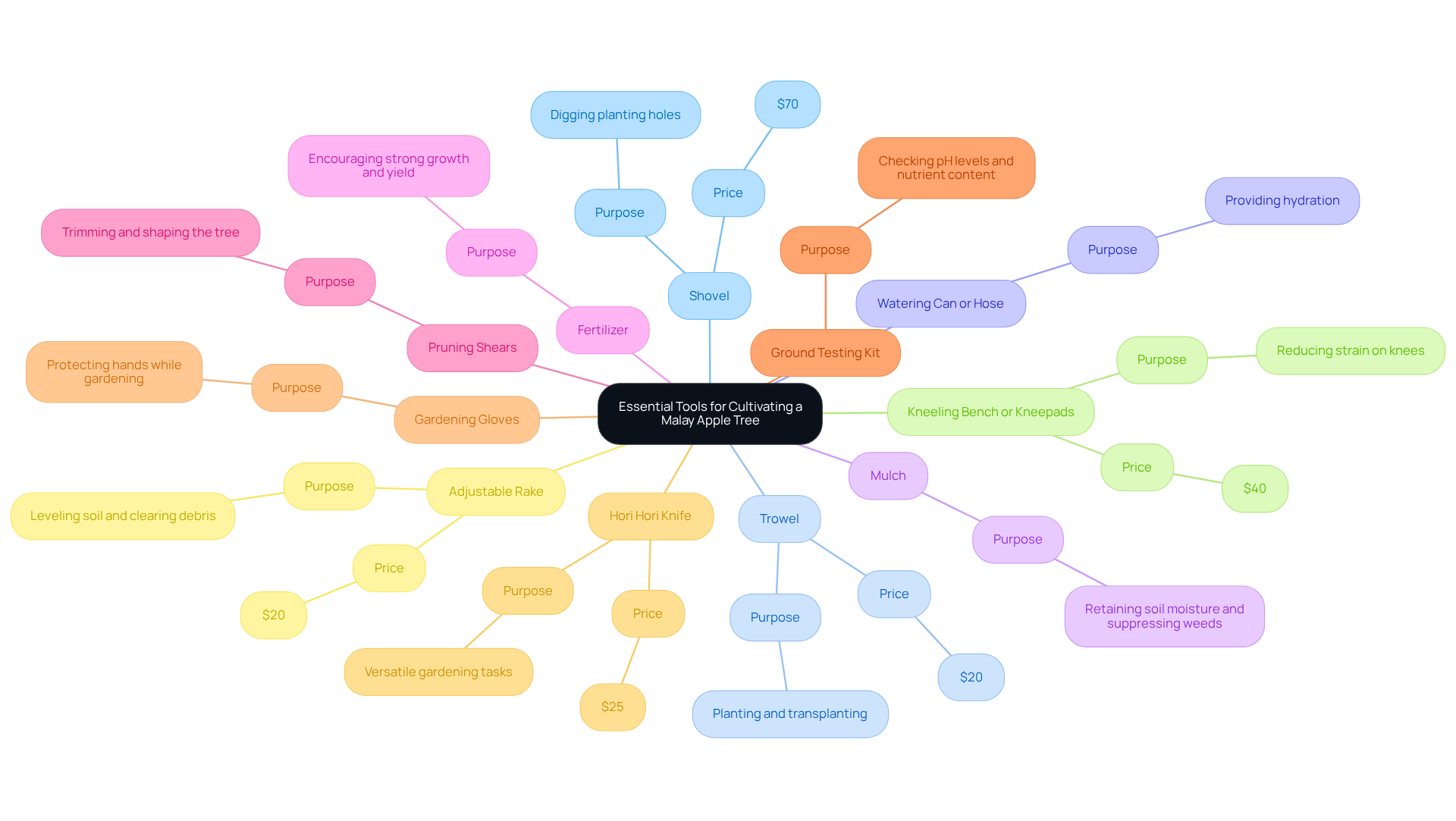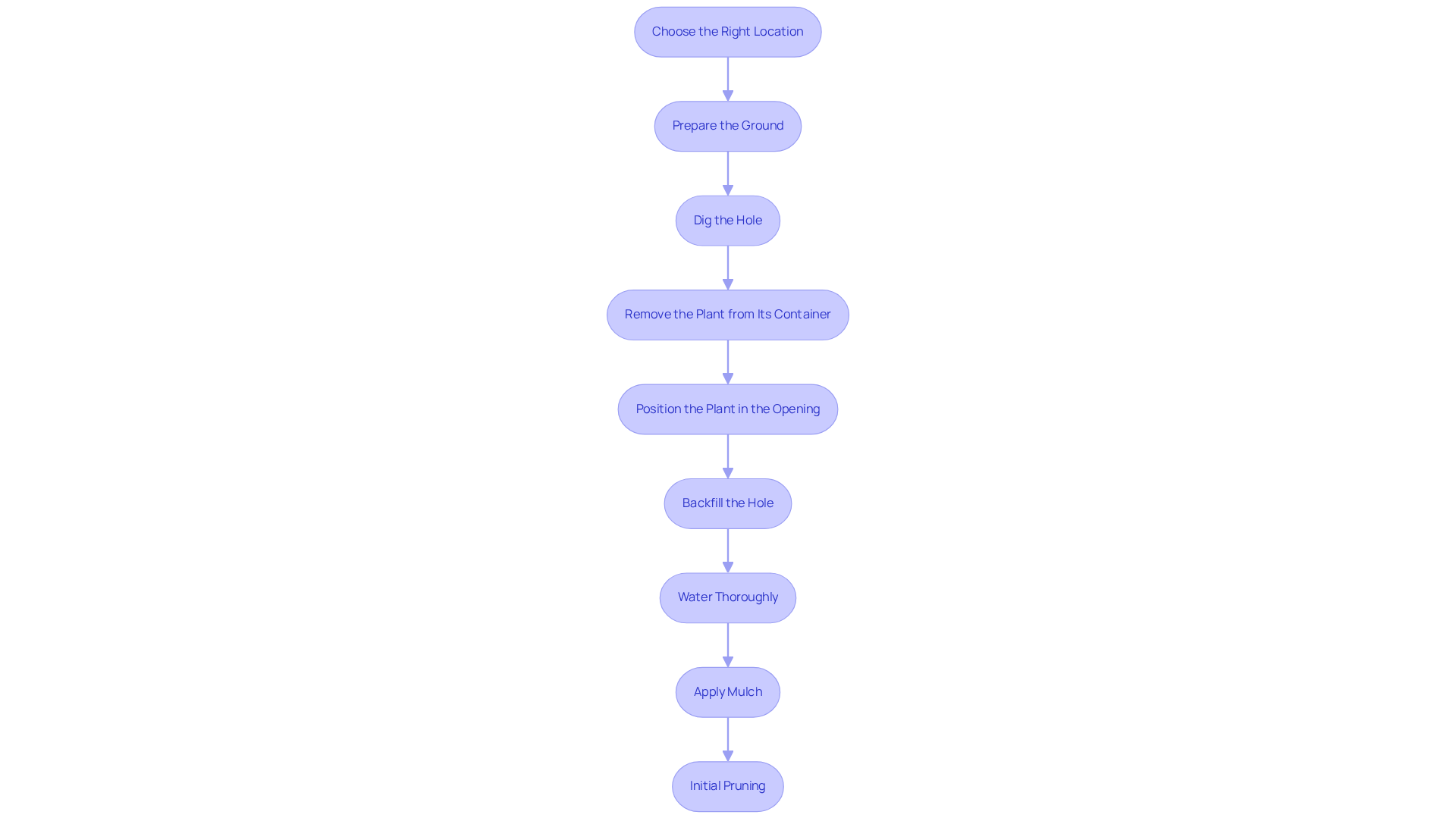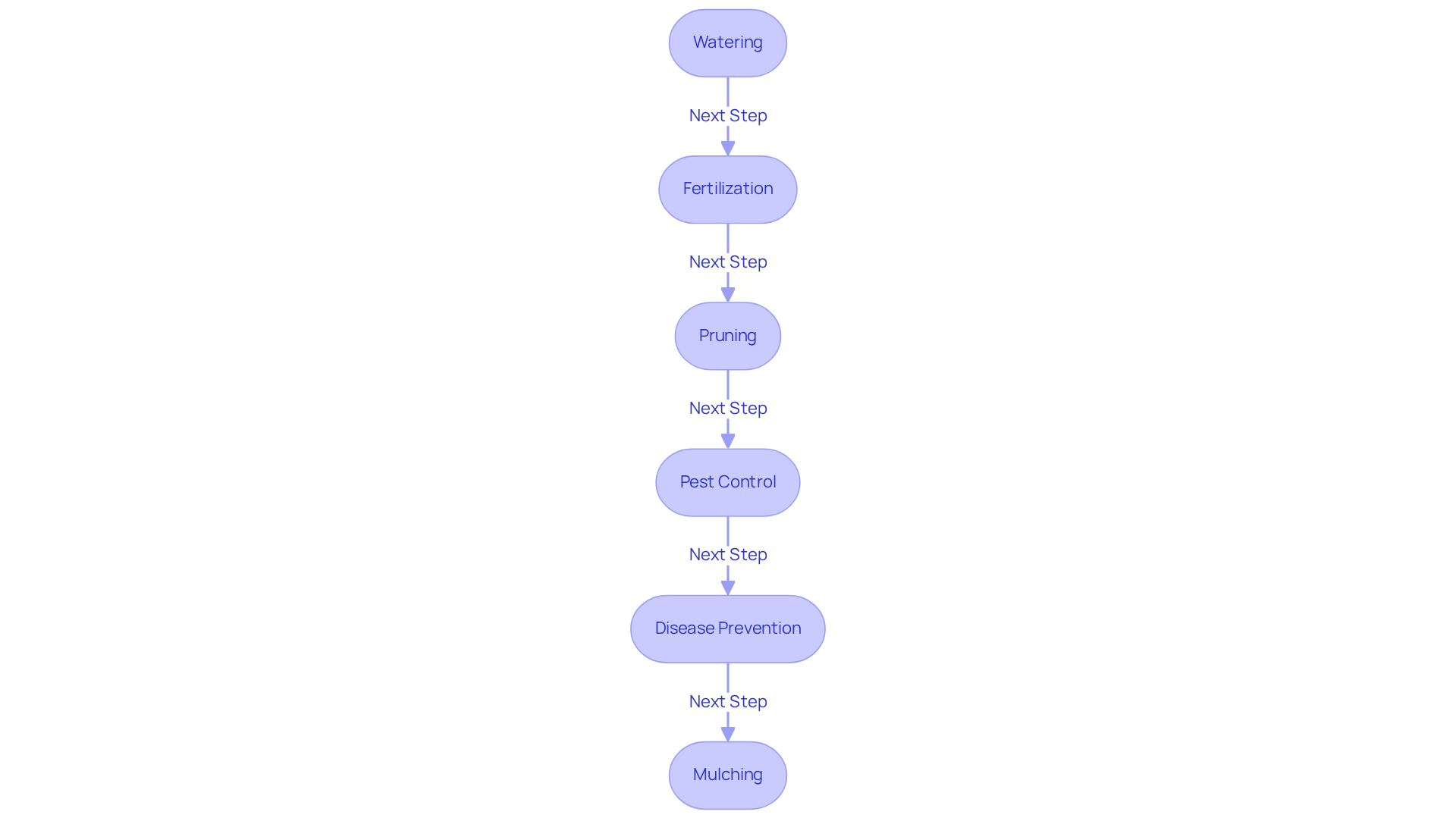
Malay Apple: Step-by-Step Guide to Successful Cultivation
Share
This article presents a comprehensive step-by-step guide for successfully cultivating a Malay apple tree. It details essential tools, planting techniques, maintenance practices, and troubleshooting common issues. By emphasizing the importance of proper preparation, consistent care, and proactive problem-solving, the article ensures that gardeners can foster healthy growth and achieve fruitful yields.
The guide begins with a clear statement of purpose, explaining the features of the Malay apple tree and the advantages of its cultivation. It provides detailed explanations of planting techniques and maintenance practices, which are crucial for success. Additionally, the article concludes with practical takeaways and tips that gardeners can implement to enhance their gardening experience.
Cultivating a Malay apple tree presents gardeners with a unique opportunity to savor the lush, tropical flavors of this exotic fruit right in their own backyard. With the appropriate tools and techniques, anyone can embark on a rewarding journey of growth and harvest, transforming their garden into a fruitful oasis. However, the path to successful cultivation is not without its challenges. Aspiring gardeners should be aware of common pitfalls and learn how to ensure their Malay apple thrives. This guide explores the essential steps, care tips, and troubleshooting strategies necessary for nurturing a robust and productive Malay apple tree.
Thinking about growing a Malay Apple tree in your garden?
Explore the Malay Apple tree for sale at Everglades Farm - shipped directly from Florida.
1. Gather Essential Tools and Materials
To successfully cultivate a Malay apple tree, it is crucial to gather the following essential tools and materials:
- Shovel: Essential for digging the planting hole, with prices starting around $70 for a sturdy option. This tool is fundamental for establishing a proper planting site.
- Trowel: A must-have for planting and transplanting smaller plants, typically priced at $20 for a durable model, facilitating precise planting.
- Watering Can or Hose: Essential for , which is crucial for the plant's establishment and growth.
- Mulch: Organic mulch helps retain soil moisture and suppress weeds, contributing to healthier growth and a more stable environment for the tree.
- Fertilizer: A balanced fertilizer specifically formulated for fruit-bearing plants is advised to encourage strong growth and yield, ensuring the tree receives necessary nutrients.
- Pruning Shears: Important for trimming and shaping the tree as it matures, with quality options available to suit various budgets, promoting healthy development.
- Ground Testing Kit: This instrument is essential for checking pH levels and nutrient content in the ground, ensuring optimal growing conditions for the tree.
- Gardening Gloves: Safeguard your hands while handling earth and plants, enhancing the gardening experience and providing comfort.
- Hori Hori Knife: A versatile instrument for various gardening tasks, priced around $25, which can be particularly useful for digging and weeding effectively.
- Adjustable Rake: Starting at $20, this implement can assist in leveling soil and clearing debris, contributing to a tidy planting area.
- Kneeling Bench or Kneepads: Priced from $40, these can reduce strain on your knees while planting and tending to your plants, making the process more comfortable.
Having these resources prepared will simplify the planting and maintenance process, facilitating the growth of a flourishing Malay apple. Investing in high-quality equipment not only boosts efficiency but also aids in the overall success of your gardening efforts. As Phyllis Turner, a master gardener, notes, "If you make it easier on you, you’re going to be doing it longer," highlighting the importance of ergonomic and effective gardening tools.

2. Plant the Malay Apple Tree
To successfully plant your Malay apple tree, follow these essential steps:
- Choose the Right Location: Select a site that receives full sun, ideally at least 6 hours a day, and has good drainage. This ensures optimal growth conditions for your tree.
- Prepare the Ground: Test the earth's pH, aiming for a range between 5.5 and 6.5. If needed, enhance the ground with organic matter to improve conditions for growth. Adding compost or well-rotted manure can significantly boost soil fertility.
- Dig the Hole: Create a hole that is twice as wide and deep as the root ball of the plant. This allows for proper root expansion, which is crucial for the tree's health.
- Remove the Plant from Its Container: Carefully take the plant out of its pot, ensuring minimal disturbance to the roots to promote successful establishment.
- Position the Plant in the Opening: Place the plant centrally in the hole, ensuring the top of the root ball is even with the surrounding earth. This positioning supports healthy growth.
- Backfill the Hole: Fill the hole with earth, gently tamping it down to remove any air pockets that could hinder root establishment. Proper backfilling is vital for the tree's stability.
- Water Thoroughly: After planting, water the plant deeply to help settle the soil around the roots and . Trees should receive at least 1 inch of water per week during dry periods. Consider using a drip irrigation system for consistent moisture.
- Apply Mulch: Add a layer of mulch around the base of the plant to retain moisture and suppress weed growth. Organic mulch, such as wood chips or straw, is ideal for maintaining soil health.
- Initial Pruning: Consider performing initial pruning to remove any dead or damaged branches, which can help promote healthy growth and enhance the tree's overall vigor.
As the saying goes, "The best moment to plant a sapling was 20 years ago; the second best moment is now." By following these steps and integrating best practices for tropical fruit plants, you will create a strong foundation for your Malay apple variety, preparing it for healthy development and abundant yields.

3. Maintain and Care for Your Malay Apple Tree
To maintain and care for your Malay apple tree, it is essential to follow these guidelines for optimal growth and productivity of the Malay apple.
- Watering is crucial; ensure the plant receives consistent moisture, particularly during dry spells. Water deeply once a week, adjusting based on rainfall to .
- Fertilization is another key aspect. Apply a balanced fertilizer every 2-3 months during the growing season. Additionally, using a high-phosphorus fertilizer during flowering can significantly enhance fruit production.
- Pruning plays a vital role in tree health. Trim the plant yearly in late winter or early spring to eliminate dead or infected branches and shape the canopy for improved air circulation, which is essential for overall vitality.
- Pest control requires regular examination of the plant for pests such as spider mites and scale insects. If necessary, organic insecticides or neem oil can be effective solutions to manage infestations and protect your tree.
- Disease prevention is critical; ensure good air circulation around the plant and avoid overhead watering to mitigate the risk of fungal diseases. Removing any fallen leaves or fruit can further reduce disease risk and promote a healthier environment.
- Finally, mulching is beneficial. Replenish mulch as needed to maintain soil moisture and suppress weeds, creating an ideal growing condition for your apple tree.
By adhering to these care practices, your plant will remain healthy and productive, ensuring a bountiful harvest of Malay apple.

4. Troubleshoot Common Issues in Malay Apple Cultivation
Cultivating malay apple plants can present various challenges. Understanding these common issues and implementing effective troubleshooting tips can significantly enhance your gardening experience.
- Yellowing Leaves: This often signals a nutrient deficiency, particularly nitrogen. Applying a balanced fertilizer with a three-number code indicating the ratio of Nitrogen, Phosphorus, and Potassium (N-P-K) can remedy this. Moreover, ensuring that the plant receives adequate watering supports nutrient uptake, as fruit-bearing plants require .
- Wilting: Wilting may indicate either overwatering or underwatering. Assess the soil moisture levels; if the soil is too dry, increase watering. Conversely, if it’s too wet, adjust your watering schedule to improve drainage.
- Pest Infestations: Pests like spider mites or scale can damage your plant. Regular inspections are crucial for early detection. If you notice an infestation, treating the plant with organic insecticides or neem oil can significantly reduce damage.
- Fungal Diseases: Conditions like leaf blotch or root rot often arise from excessive moisture. Ensuring proper drainage is essential to prevent waterlogging. Remove any affected leaves and consider applying fungicides to control the spread of disease effectively.
- Poor Fruit Production: If your plant is not yielding fruit, evaluate its exposure to sunlight and the effectiveness of pollination. Additionally, confirm that the plant is receiving sufficient nutrients and water to support fruit development. Conducting a proactive ground test can assist in evaluating trace mineral levels and determining if fertilization is needed.
By proactively addressing these common issues and considering the importance of soil testing and nutrient management, you can foster a healthy and productive malay apple tree, ultimately enhancing your gardening experience.

Conclusion
Successfully cultivating a Malay apple tree requires careful planning and execution, starting with the right tools and materials. Selecting an optimal location and understanding the nuances of watering, fertilization, and pest management are essential steps that play a crucial role in ensuring the tree's health and productivity. This guide has illuminated the essential practices necessary for nurturing a flourishing Malay apple, emphasizing the importance of preparation and ongoing care.
Key points discussed include the necessity of gathering the right tools, such as shovels and watering cans, and following a systematic approach to planting. The article delves into maintenance strategies, including:
- Consistent watering
- Appropriate fertilization
- Regular pruning
These collectively contribute to the overall vitality of the tree. Additionally, troubleshooting common issues such as yellowing leaves, wilting, and pest infestations allows gardeners to proactively address challenges, ensuring a bountiful harvest.
In conclusion, cultivating a Malay apple tree is not merely about planting; it is a commitment to ongoing care and attention. By adopting best practices and remaining vigilant against potential issues, gardeners can enjoy the rewards of their efforts in the form of delicious fruit and a thriving tree. Embrace the journey of growing your Malay apple tree, and take the first step today towards a fruitful gardening experience.
Grow Your Own Tropical Paradise Today!
Start your journey with a healthy Malay apple tree from Everglades Farm and enjoy delicious fruit in no time.
🛒 Buy Malay Apple Tree
👉🏻 Explore Fruit Trees Collection
Frequently Asked Questions
What essential tools are needed to cultivate a Malay apple tree?
The essential tools needed include a shovel, trowel, watering can or hose, mulch, fertilizer, pruning shears, ground testing kit, gardening gloves, Hori Hori knife, adjustable rake, and a kneeling bench or kneepads.
Why is a shovel important for planting a Malay apple tree?
A shovel is essential for digging the planting hole, establishing a proper planting site, and ensuring the tree has the right space to grow.
What is the purpose of using mulch when planting a Malay apple tree?
Organic mulch helps retain soil moisture and suppress weeds, contributing to healthier growth and a more stable environment for the tree.
How does fertilizer benefit the Malay apple tree?
A balanced fertilizer specifically formulated for fruit-bearing plants encourages strong growth and yield by providing the necessary nutrients for the tree.
What is the function of pruning shears in the care of a Malay apple tree?
Pruning shears are important for trimming and shaping the tree as it matures, promoting healthy development.
Why is a ground testing kit necessary?
A ground testing kit is essential for checking pH levels and nutrient content in the soil, ensuring optimal growing conditions for the tree.
What role do gardening gloves play in the planting process?
Gardening gloves safeguard your hands while handling earth and plants, enhancing comfort and the overall gardening experience.
What is a Hori Hori knife used for?
A Hori Hori knife is a versatile instrument useful for various gardening tasks, particularly effective for digging and weeding.
How can an adjustable rake assist in planting?
An adjustable rake can help level soil and clear debris, contributing to a tidy planting area.
What benefits do kneeling benches or kneepads provide?
Kneeling benches or kneepads reduce strain on your knees while planting and tending to your plants, making the gardening process more comfortable.

![Malay Apple [Otaheite Apple] Tree](https://cdn.shopify.com/s/files/1/0014/1377/5433/files/Screenshot_2025-08-11_at_7.04.02_p.m..png?v=1754960649)
